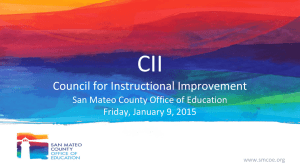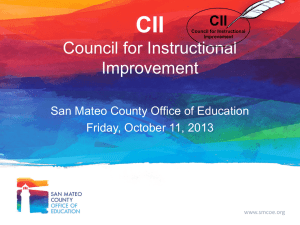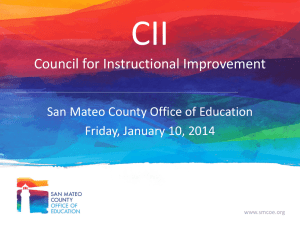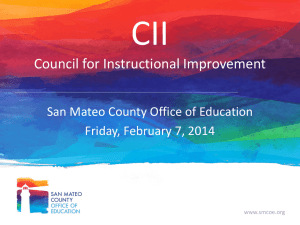How can we develop literate students ready for the
advertisement
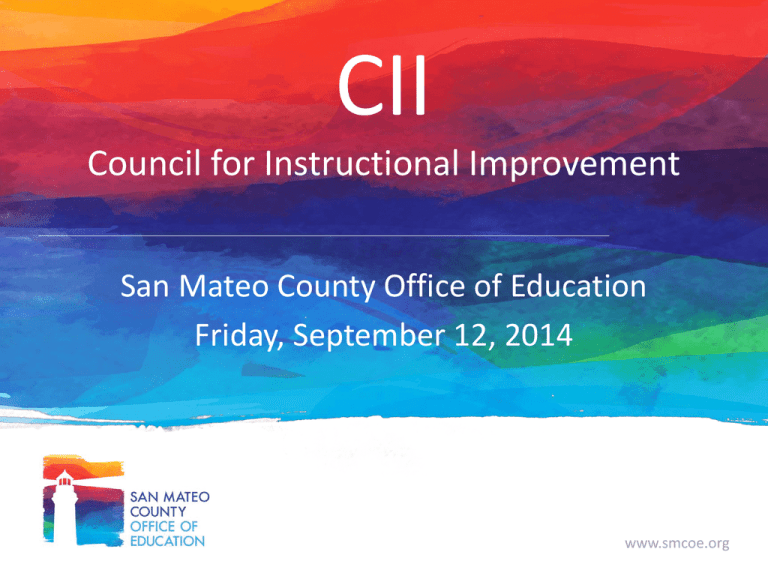
CII Council for Instructional Improvement San Mateo County Office of Education Friday, September 12, 2014 www.smcoe.org Agenda Welcome, Review Agenda Supporting Readers/Writers Workshop Expository Reading and Writing Course (ERWC) Achievement in Motion (AIM) CCSS Curriculum Development Professional Learning Opportunities 2014-2015 www.smcoe.org Supporting Readers/Writers Workshop www.smcoe.org Lucy Calkins for Administrators • Superintendents • Associate/Assistant Superintendents • Principals October 27, 2014 9:00 to 3:00 San Mateo County Office of Education www.smcoe.org Curriculum Support • • • • 2 Day Writing Workshop Training Units of Study Facilitation grade level meetings Coaching support www.smcoe.org Preceding Writing Workshop Activities: Standards Alignment Goals: – Note the new work at each grade level – Opportunity to understand the “trajectory along which writers can travel” – Breaks down skills into incremental steps – All units of study designed with this trajectory 6 www.smcoe.org Preceding Writing Workshop Activities: Learning Progressions Goals: – Gain familiarity with the tool – Identify the similarities & differences between CCSS writing standard and the learning progression – See how the “trajectory along which writers can travel” plays out in the curriculum 7 www.smcoe.org Examining Student Writing www.smcoe.org Examining Student Work Sample www.smcoe.org Examining Student Work Using the Learning Progression Tool 1. Read the student work sample 1. Decide which grade level it matches on the narrative writing learning progression ● What are this student’s strengths? ● What does the student still need? ● What would be a next step for the student, knowing you want to move the student up one grade level? www.smcoe.org What Did You Notice? www.smcoe.org Writing Workshop Learning Progression This tool is used to analyze student work to determine a student’s strengths as a writer and to set individual learning goals. RUBRIC www.smcoe.org Expository Reading & Writing Course ERWC www.smcoe.org Are San Mateo County Students Ready for College? www.smcoe.org EAP Data & San Mateo County http://www.calstate.edu/eap/ www.smcoe.org 7 Key Principles of ERWC 1. The integration of interactive reading and writing processes 2. A rhetorical approach that fosters critical thinking and engagement through relentless focus on the text 3. Materials and themes that engage student interest 4. Classroom activities designed to model and foster successful practices of fluent readers and writers 5. Research-based methodologies with a consistent relationship between theory and practice 6. Built-in flexibility to allow teachers to respond to varied students’ needs and instructional contexts 7. Alignment with California’s CCSS for ELA and Literacy www.smcoe.org Assignment Template Overview • Left hand column describes the intentions behind the activities for each section • Right hand column are the key questions behind each type of activity • Remember, the overall intention is to scaffold the whole process for students www.smcoe.org www.smcoe.org Key Objective of the CCSS is to prepare college and career ready students who… …meet the Standards readily undertake the close, attentive reading that is at the heart of understanding and enjoying complex works of literature. They habitually perform the critical reading necessary to pick carefully through the staggering amount of information available today in print and digitally. They actively seek the wide, deep, and thoughtful engagement with high-quality literary and informational texts that builds knowledge, enlarges experience, and broadens worldviews. They reflexively demonstrate the cogent reasoning and use of evidence that is essential to both private deliberation and responsible citizenship in a democratic republic. In short, students who meet the Standards develop the skills in reading, writing, speaking, and listening that are the foundation for any creative and purposeful expression in language. http://www.corestandards.org/ELA-Literacy www.smcoe.org Reading Against the Grain: An ERWC Activity What techniques is this author using to persuade the reader? www.smcoe.org Argumentative Appeal Ethos is a person’s credibility with a given audience. It can mean sincerity, authority, expertise, faithfulness, or any adjective that describes someone you can trust to do the right thing. Ethos is related to the English word ethics and refers to the trustworthiness of the speaker/writer. Ethos is an effective persuasive strategy because when we believe that the speaker does not intend to do us harm, we are more willing to listen to what s/he has to say. Pathos appeals rely on emotions and feelings to persuade the audience. They are often direct, simple, and very powerful; Whenever you accept a claim based on how it makes you feel without fully analyzing the rationale behind the claim, you are acting on pathos- emotions: love, fear, patriotism, guilt, hate, joy etc. Logos appeals rely on the audience’s intelligence to persuade them. Logos refers to any attempt to appeal to the intellect, the general meaning of "logical argument." www.smcoe.org Rhetorical Reading in Action www.smcoe.org Rhetorical Reading in Action 1. Get into groups of 2 or 3. Continue reading paragraphs 4-7 in small groups to determine ethos, pathos, or logos for each paragraph 1. Individually, continue reading paragraphs 8 - 11 and determine ethos, pathos, or logos for each paragraph www.smcoe.org Rhetorical Reading in Action: Postreading • Students are asked to think critically and move beyond initial reactions • Gain a deeper understanding of the text by questioning and analyzing rhetorical choices of the author www.smcoe.org Rhetorical Reading in Action In what ways does this type of activity positively support balanced literacy? www.smcoe.org Achievement in Motion: Closing the Gap Mefula Fairley Administrator, Educational Support Services www.smcoe.org AIM • Shines a spotlight on quality learning opportunities that have resulted in improved educational outcomes for historically underserved students • Informs the public and shares best practices • Highlights a different San Mateo County school district, school site, program or individual educator on the SMCOE website every 4-6 weeks • Accepts nominations from school district employees in San Mateo County via survey monkey: https://www.surveymonkey.com/s/achievementinmotion www.smcoe.org BREAK www.smcoe.org Using the CCSS to Improve Student Outcomes Curriculum Design Process Tracy Wilson – SMCOE Cregg Ramich – South San Francisco USD Genevieve Schwartz Thurtle – San Mateo Union HSD Pam Mooers – San Bruno Park SD Sarah Cullom – San Mateo-Foster City SD Julie Costantino – Millbrae SD www.smcoe.org Objectives How can we develop literate students ready for the complex texts and tasks of the 21st century? • Share a collaborative process for designing and refining lesson/units. • Focus on the process. • Use the lessons as a vehicle to support reflective, intentional instruction. • Thoughtfully discuss instruction and curriculum to elevate practice and consciousness. • Support profound personal and collective growth www.smcoe.org Prospective Uses How can we develop literate students ready for the complex texts and tasks of the 21st century? Positive Outcomes Problematic Outcomes • Collaborative lesson review and reflection • See the CCSS shifts • Realistic vision and models for next steps • On-going reflective practices • A rebalanced focus on instruction and content • Coherent and intentional practices • Copying the lessons • Adopt with fidelity • Design with fidelity to the template • Independent practice, isolated • Single event or experience www.smcoe.org ELA/ELD Key Themes and Practices www.smcoe.org CDE ELA/ELD Cross-cutting Practices What: CCSS • Build Content Knowledge • Make Meaning • Develop Effective Expression: Communicating verbally and in various print forms • Develop Language/Academic Vocabulary • Develop Foundational Skills How: Instructional Practices • Engaging throughout a lesson/unit • Respectful of student culture and experiences and needs • Motivating and Challenging • Integrated: Literacies and Content Reflection and Projection How can we develop literate students ready for the complex texts and tasks of the 21st century? Review of common documents How do you build community vision? www.smcoe.org Pre-Think How can we develop literate students ready for the complex texts and tasks of the 21st century? Discussion What is the architecture of a quality unit of instruction? Brainstorm the parts. www.smcoe.org Jigsaw How can we develop literate students ready for the complex texts and tasks of the 21st century? Share Responsibility Preview your lesson sample and identify the key structures (architecture). www.smcoe.org Read Closely How can we develop literate students ready for the complex texts and tasks of the 21st century? Multiple Lens Reading, 50/50 Reading What: Look for examples of these shifts! • Build Content Knowledge • Make Meaning • Develop Effective Expression: Communicating verbally and in various print forms • Develop Language/Academic Vocabulary • Develop Foundational Skills www.smcoe.org Read Closely How can we develop literate students ready for the complex texts and tasks of the 21st century? Multiple Lens Reading, 50/50 Reading How: Look for examples of these instructional shifts • Engaging throughout a lesson/unit • Respectful of student culture, experiences, needs • Motivating and Challenging • Integrated: Literacies and Content www.smcoe.org Read Closely How can we develop literate students ready for the complex texts and tasks of the 21st century? Getting Started… Select a key document to help you analyze the strengths in this unit/lesson 1. Identify promising teacher practices 1. Identify key outcomes for students www.smcoe.org Jotting Dots How can we develop literate students ready for the complex texts and tasks of the 21st century? Student Profiles Jot Dots 1. Discuss a student profile that you think slips through the cracks a bit 2. A student who could benefit from stronger models of differentiation 3. Jot Dots: Describe that student on a card, 35 bullets only! www.smcoe.org Obstacles and Opportunities How can we develop literate students ready for the complex texts and tasks of the 21st century? Student Profiles Pass the Profile! 1. Adopt a Student! 2. Revisit the lesson and look for indicators of differentiation that might meet your students needs 3. Modify/magnify/sweep/keep practices www.smcoe.org Jigsaw How can we develop literate students ready for the complex texts and tasks of the 21st century? Share Responsibility Revisit your lesson sample and identify the key elements and promising practices of an effective lesson/unit! www.smcoe.org Re-Vision How can we develop literate students ready for the complex texts and tasks of the 21st century? Discussion What is the architecture of a quality unit of instruction? Revise your criteria list. www.smcoe.org Our Process Prepare for a critical conversation • Choose a resource to help guide your analysis Share your Lesson • Describe the architecture of your unit and your lesson • Discuss your lesson focus and highlight your lesson strengths • Prompt suggestions, areas you are hoping to improve upon Critical Conversation • Clarifying questions • Strengths, promising practices • Suggestions or opportunities for improvement Collaboration • Develop a look for or must do list for unit design Our Progression • • • • • • • • • • • • Central/guided questions Standards listed Materials/resources Overview narrative + summative piece (outcome) 1-2 key lessons- include instructional practices… explicit ref to instructional shifts about teacher roles/ student behaviors • • 1-2 formative assessments Summative rubric Year at a glance… one page overview WHY// Instructional Practices (annotations// Meeting student needs// DOK Texture texts… cross curricular connection DOK clarified within the lessons Writing piece… making a claim and supporting evidence • • • • • • • • Central/guided questions Focus Standards (2-4) for the specific lesson Materials/resources- cross curricular connection if possible Overview narrative of the unit referencing specifically the lesson that is detailed Lesson agenda /outline with timeframe Summative piece (outcome) rubric/ measuring tool to guide teacher observation 1-2 key lessons detailedTeacher look for¹s Student outcomes or objectives Texture texts • • • • • • • • • • • • 1-2 formative assessments Summative and rubric Year at a glance… one page overview WHY// Instructional Practices (annotations// Meeting student needs// DOK DOK clarified within the lessons Writing piece… making a claim and supporting evidence Overview of the Unit - narrative of the unit referencing specifically the lesson that is detailed Central Questions Focus CCS Standards: (2-4) for the specific lesson CCSS Shift Learning Outcomes Materials/resources: cross curricular Texture texts for enrichment and to increase NF Agenda: or outline with timeframes Formative Assessment practices Summative Assessment: developmental rubric 1-2 key lessons detailed- include instructional practicesŠ Teaching Considerations- inquiry model of questioning; ELD-up it! Teaching Channel- how to sample lessons 1-2 formative assessments Summative and rubric Year at a glance… one page overview WHY// Instructional Practices (annotations// Meeting student needs// DOK DOK clarified within the lessons Writing piece… making a claim and supporting evidence Our Progression • • • • • • • • • • • • Central/guided questions Standards listed Materials/resources Overview narrative + summative piece (outcome) 1-2 key lessons- include instructional practices… explicit ref to instructional shifts about teacher roles/ student behaviors • • 1-2 formative assessments Summative rubric Year at a glance… one page overview WHY// Instructional Practices (annotations// Meeting student needs// DOK Texture texts… cross curricular connection DOK clarified within the lessons Writing piece… making a claim and supporting evidence • • • • • • • • Central/guided questions Focus Standards (2-4) for the specific lesson Materials/resources- cross curricular connection if possible Overview narrative of the unit referencing specifically the lesson that is detailed Lesson agenda /outline with timeframe Summative piece (outcome) rubric/ measuring tool to guide teacher observation 1-2 key lessons detailedTeacher look for¹s Student outcomes or objectives Texture texts • • • • • • • • • • • • 1-2 formative assessments Summative and rubric Year at a glance… one page overview WHY// Instructional Practices (annotations// Meeting student needs// DOK DOK clarified within the lessons Writing piece… making a claim and supporting evidence Overview of the Unit - narrative of the unit referencing specifically the lesson that is detailed Central Questions Focus CCS Standards: (2-4) for the specific lesson CCSS Shift Learning Outcomes Materials/resources: cross curricular Texture texts for enrichment and to increase NF Agenda: or outline with timeframes Formative Assessment practices Summative Assessment: developmental rubric 1-2 key lessons detailed- include instructional practicesŠ Teaching Considerations- inquiry model of questioning; ELD-up it! Teaching Channel- how to sample lessons 1-2 formative assessments Summative and rubric Year at a glance… one page overview WHY// Instructional Practices (annotations// Meeting student needs// DOK DOK clarified within the lessons Writing piece… making a claim and supporting evidence How We Got Started Day 1 Day 2-6 Next Steps (?) • Analyze and share resources to support a common vision • Close reading of external high quality lessons (ENY, ERWC, Stanford-UL) • Call out promising practices • Craft a criteria list for designing our units/lessons • Share and discuss “visionary” resources • Share and analyze personal lessons • Gather critical feedback • Re-craft a criteria list for designing quality lessons • Identify strategic next moves, disciplined approach • Solidify collaborative structures • Elevated collegial conversations around lessons and or units • Peer observations and reflection • Analyze student progress/work • Generate a template for lesson/unit design • Curriculum design or framework: 6-9 units a year Think Through… What should we think about when guiding our schools and teachers to design or adopt units of instruction? 1. How are you supporting a common vision and what resources or practices are common among your schools/teachers? 1. What structures and processes should you support to allow for collaborative conversations around lesson design and refinement? www.smcoe.org Next Steps? www.smcoe.org Professional Learning Opportunities • • • • • • CII meetings for 2014-2015 SMCOE Booklet of Offerings CCSS Conference – January 29, 2015 Zap the Gap Conference – March 9, 2015 Leading Edge Certification STEM Opportunities www.smcoe.org Next CII – October 10, 2014 Focus on: English Learners and the ELA/ELD Framework www.smcoe.org
